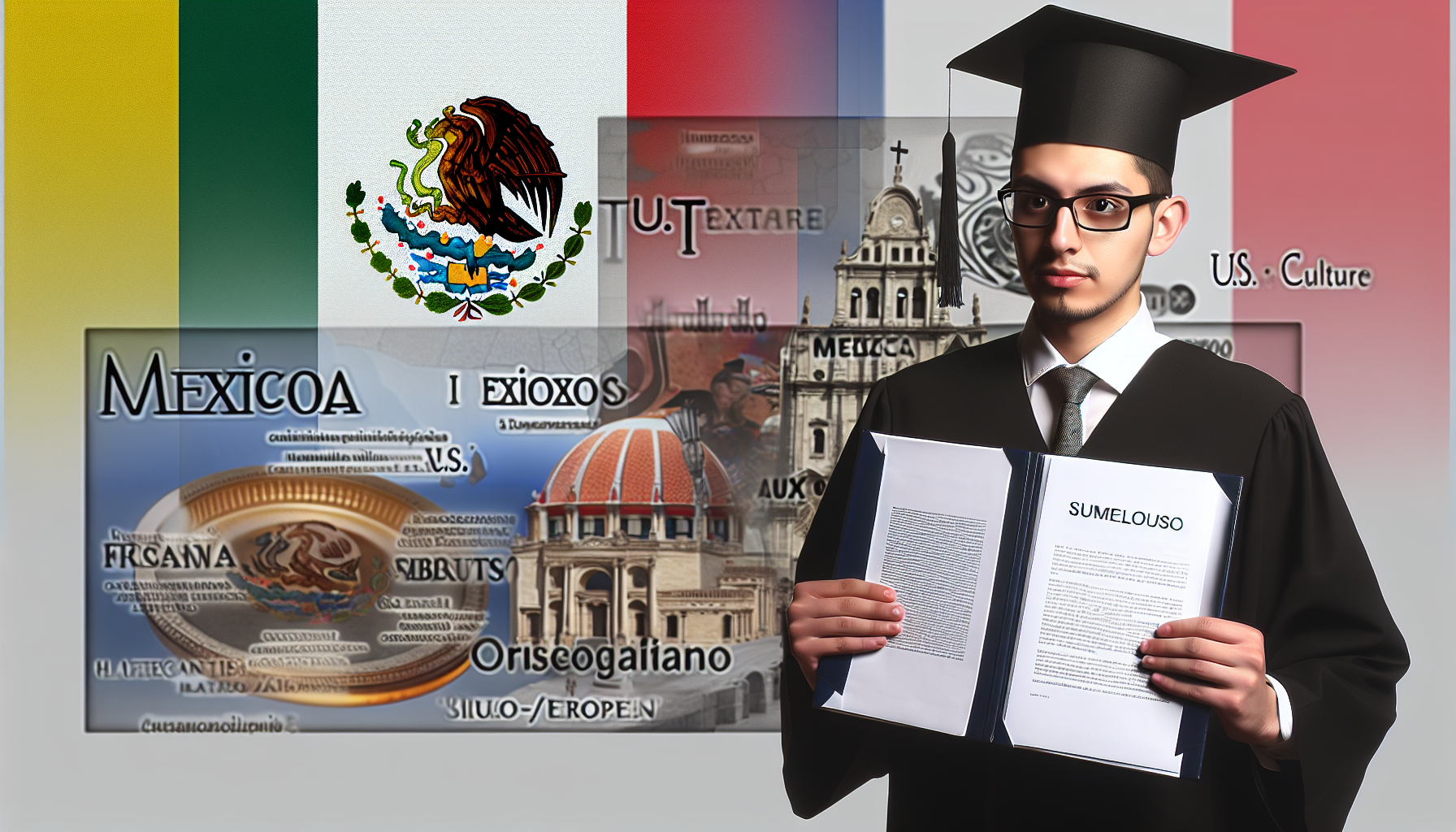Educational Standards Comparison: Mexico, the United States, and Europe
Educational standards in Mexico, the United States, and Europe reveal both significant differences and notable similarities that shape the academic landscape.
In Mexico, the education system is governed by the Secretaría de Educación Pública (SEP), which establishes a national curriculum emphasizing bilingual education and a focus on civic values. Mexican education is divided into three levels: basic education (primary and secondary), upper secondary, and higher education, with a strong emphasis on foundational knowledge, particularly in mathematics and sciences, as outlined in the OEI report.
In contrast, the educational system in the United States is decentralized, with each state regulating its education standards through local school districts. U.S. education spans K-12 (from kindergarten through 12th grade) and post-secondary education, including community colleges and universities. The focus is often on critical thinking and skills development across a wide range of subjects, allowing students to follow specialized coursework based on their interests. The U.S. Department of Education emphasizes standards through frameworks such as the Common Core State Standards, which outline essential math and English language skills for K-12 students.
Meanwhile, Europe presents a diverse educational landscape with varying standards across the European Union (EU) countries; however, initiatives like the Bologna Process aim to create a more cohesive higher education framework. The commitment to a lifelong learning approach is evident within European educational systems, fostering mobility and recognition of qualifications across borders. According to a European Commission report, the processes implemented encourage transparency in qualifications and promote comparability among European degrees.
Despite these differences, all three regions share a commitment to improving education quality and accessibility, focusing on preparing graduates for a modern, interconnected world. Understanding these educational frameworks will enable Mexican graduates to craft competitive syllabi and adapt their learning experiences for diverse academic and professional environments. For further insights into adjusting academic approaches globally, refer to our article on education policy comparisons.
Creating a Comprehensive Syllabus
Creating a syllabus that addresses the needs of students in both the U.S. and Europe requires incorporating several critical components. Here’s an outline of essential elements to consider when designing a course syllabus that ensures clarity and alignment with educational objectives:
1. **Course Objectives**: Clearly state what students are expected to learn by the end of the course. Objectives should be specific, measurable, achievable, relevant, and time-bound (SMART). For example, objectives might include skills such as critical thinking, collaboration, and specific subject knowledge.
2. **Competencies**: Outline the skills and knowledge that students are expected to acquire. This can include both soft skills (like communication and teamwork) and hard skills (such as technical proficiency relevant to the field of study). Competencies should align with both institutional standards and industry expectations to prepare students for future challenges.
3. **Grading Criteria**: Detail the assessment methods that will be used to evaluate student performance. This includes information about assignments, projects, exams, and participation, along with the weight each component carries towards the final grade. Clear grading rubrics can help ensure students understand how their work will be evaluated, which reinforces fairness and transparency in grading practices.
4. **Course Schedule**: Provide a detailed timeline of topics to be covered, including key readings and deadlines for assignments. This schedule should allow for flexibility and adjustments in response to different learning paces or unforeseen circumstances.
5. **Policies and Expectations**: Include clear policies regarding attendance, participation, and academic integrity. This section should also outline the expectations for communication between students and instructors, including response times for emails and office hours.
6. **Resources and Support**: List required and recommended readings, materials, and any support services available to students, such as tutoring and counseling. This section guides students in preparing and accessing necessary materials throughout the course.
7. **Diversity and Inclusion Statement**: Incorporate a commitment to fostering an inclusive learning environment that respects diversity. This can enhance student engagement and support an equitable learning experience.
By integrating these components, a syllabus can effectively serve as a comprehensive roadmap for both instructors and students, setting a clear foundation for the course. Emphasizing these elements ensures that the syllabus meets educational standards and addresses the unique needs of learners in various educational contexts across the U.S. and Europe. For more insights on crafting effective course descriptions, explore our resource on course-design strategies.
Translating a Syllabus from Spanish to English
Translating a syllabus from Spanish to English requires attention to clarity and precision in academic language. Here’s a step-by-step process to achieve this:
1. **Review the Original Document**: Familiarize yourself with the syllabus content, structure, and purpose. Pay attention to key terms related to the course subject, as these will need to be accurately translated.
2. **Define Technical Vocabulary**: Identify and create a glossary of specific terminology used within the subject area, consulting academic resources or existing translated materials to ensure consistency in terms.
3. **Initial Translation**: Begin translating the document sentence by sentence, maintaining the original meaning and context. Use straightforward language to reflect the academic tone. Tools like Google Translate can assist but rely on them sparingly to avoid inaccuracies.
4. **Focus on Clarity**: Ensure that the translated content is clear and accessible to English-speaking audiences, particularly if they are not experts in the subject. Shorter sentences and simple structures might help convey complex ideas more effectively.
5. **Formatting Consistency**: Preserve the original formatting, such as headings and bullet points, to make the document user-friendly. Ensure that any timelines or schedules are correctly adapted to match the conventions used in English-speaking countries.
6. **Proofreading and Comparison**: After the initial translation, proofread the document for grammatical errors and fluency. Consider comparing sections of the translation with the Spanish original to verify that important details have not been omitted or misinterpreted.
7. **Peer Review**: If possible, have another bilingual individual review your translation. They can spot nuances and provide feedback on terminology use and readability.
8. **Incorporate Feedback**: Make any final adjustments based on peer feedback to improve clarity and precision in academic language.
By adhering to these steps, one can enhance the effectiveness of translating an academic syllabus while preserving its integrity. For more in-depth academic writing tips, refer to our article on Tips for Effective Academic Writing.
Formatting a Syllabus for U.S. and European Standards
To effectively format a syllabus that aligns with U.S. and European higher education institutions, several best practices must be considered, focusing on layout, citation styles, and language nuances.
**1. Clear Layout and Structure:**
– Organize the syllabus into distinct sections: Course Information, Instructor Details, Course Objectives, Required Readings, Assessment Methods, and Class Schedule. This clarity aids both instructors and students in navigating the document.
– Use headings and subheadings to enhance readability. Bold text for section titles can also help important information stand out.
**2. Citation Styles:**
– Adhere to the appropriate citation style, which may vary by discipline. Common styles include APA, MLA, and Chicago. For example, the American Psychological Association (APA) style requires in-text citations and a reference list at the end. For further information, consult the Purdue Online Writing Lab (OWL) for citation guidelines.
– Ensure consistency; all citations within the syllabus should follow the selected style strictly.
**3. Language and Tone:**
– Use formal and professional language, appropriate for an academic setting. Avoid jargon unless necessary, and define any specialized terms used.
– Incorporate inclusive language to respect diversity among students. This includes using gender-neutral terms and considering cultural differences when referencing examples.
**4. Accessibility Considerations:**
– Ensure the syllabus is accessible to all students, including those with disabilities. This may involve using readable fonts, providing alternative text for images, and ensuring compatibility with screen readers.
**5. Compliance with Institutional Policies:**
– Familiarize yourself with any institutional formatting guidelines, as many universities may have specific requirements for syllabus content and layout. Check resources available at your institution, such as the course description website for additional guidance.
Implementing these best practices can help create a comprehensive and effective syllabus that meets the expectations of both U.S. and European higher education institutions, fostering a conducive learning environment for all students.
Resources for Translating and Formatting Academic Syllabi
For Mexican graduates seeking effective tools and resources to translate and format their academic syllabi, the following options can be highly beneficial:
1. **Online Translation Tools**: Services like Google Translate and DeepL can help quickly translate syllabus content. While these tools are convenient, it’s advisable to have a native speaker or a professional service review the translations for accuracy and contextual relevance.
2. **Formatting Tools**: Microsoft Word and Google Docs offer various templates specifically designed for academic syllabi. Utilizing these templates can ensure that graduates present their syllabi in a standardized and professional format.
3. **Academic Writing Resources**: Websites like Purdue OWL provide extensive guides on academic writing styles, which can assist in correctly formatting citations and references in syllabi.
4. **Collaboration Platforms**: Tools such as Google Drive or Dropbox enable graduates to collaborate with peers or mentors on syllabus revisions, allowing for real-time feedback and updates.
5. **Customizable Syllabus Software**: Platforms like Course Description specialize in helping educators create clear and structured syllabi, providing examples and best practices tailored for various educational contexts.
6. **Language Exchange Programs**: Engaging in language exchange can enhance both translation skills and language proficiency. Platforms like Tandem or HelloTalk connect users with native speakers.
By leveraging these resources, Mexican graduates can effectively translate and format their syllabi to meet academic standards.










